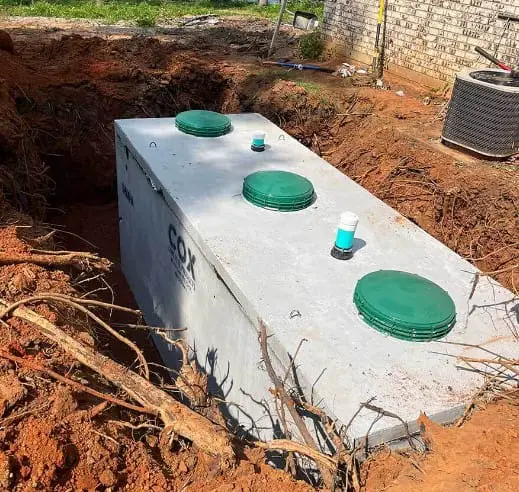Septic tanks are typically buried at a depth of 1 to 2 feet underground. Septic tanks are an integral part of many residential and commercial properties, but not everyone is familiar with how they are installed.
One common question that arises is, “How deep are septic tanks buried? ” The answer is quite simple – septic tanks are typically buried at a depth of 1 to 2 feet underground. This depth allows for proper insulation, protection from freezing temperatures, and easy access for maintenance and repairs.
Understanding the depth at which septic tanks are buried is essential for homeowners and property owners to ensure the efficient and long-lasting operation of their septic systems. We will explore the reasons behind the ideal burial depth and the benefits it offers.
Septic Tank Depth Essentials
Septic tank burial depth is an important consideration when it comes to the proper functioning of the system. The depth at which a septic tank is buried is determined by several factors. One of the key factors is the type of soil in which the tank is installed. For instance, if the soil is sandy or loamy, a shallower burial depth may be sufficient. However, if the soil is clayey or has a high water table, a deeper burial depth may be necessary to prevent contamination of the groundwater.
In general, the minimum depth of a septic tank is typically determined by local building codes or regulations. This ensures that the tank is buried deep enough to provide adequate separation between the waste and the groundwater. On the other hand, the maximum depth of a septic tank is often limited by practical considerations, such as the ease of installation and maintenance. Burial depths typically range from 2 to 4 feet below ground level.
Importance Of Proper Burial Depth
Proper burial depth is crucial for septic tanks as it balances protective covering and accessibility. The depth at which septic tanks are buried plays a significant role in preventing potential issues such as freezing and crushing.
Septic tanks must be buried at a depth that provides adequate soil coverage to protect it from the elements, including harsh weather conditions and the weight of heavy objects above. Insufficient soil covering can result in the freezing of the tank, leading to system malfunction and costly repairs. On the other hand, excessive burial depth can make the tank difficult to access for regular maintenance and inspections.
To ensure optimal performance and longevity of the septic tank, a balance must be struck between protective covering and accessibility. Consulting with a professional and adhering to local regulations and guidelines can help determine the appropriate burial depth for a septic tank.
Regulations Influencing Burial Depth
Septic tank burial depth is regulated by both federal and local guidelines. The exact depth requirements can vary based on the location and specific codes enforced in that area.
Federal septic system guidelines provide a baseline for the minimum burial depth. These guidelines are generally designed to ensure proper functionality and prevent contamination. However, variations in burial depth codes exist among different regions.
These are general examples, and the actual requirements in your specific area may differ. It’s essential to consult local authorities or hire a professional to ensure compliance with the regulations.
Depth Factors And Tank Performance
Septic tanks are typically buried at a specific depth to ensure optimal performance. The depth at which a septic tank is buried is influenced by various factors, including soil characteristics and percolation rate. The percolation rate refers to how quickly water is absorbed by the soil. Soils with a higher percolation rate can handle a higher volume of wastewater and may require a shallower burial depth.
Another important consideration is the impact on groundwater and surface water. Septic tanks must be buried deep enough to prevent contamination of these water sources. Regulations typically require septic tanks to be buried at least a certain distance above the water table or any nearby water bodies.
It’s worth noting that the required burial depth may vary depending on local regulations and conditions. The depth of burial can also be influenced by factors such as climate, site slope, and proximity to sensitive areas. Consulting with a professional septic system installer or local health department can provide specific guidance for your location.
How Deep Are Septic Tanks Typically Buried?
Sep%span>tic tanks are an essential part of a home’s wastewater system. On%span>e important factor to consider when installing a septic tank is how deep it should be buried. The typical depth of septic tanks can vary based on the tank size and local codes. Generally, smaller tanks with a capacity of 1,000 gallons or less are buried at a depth of about 2 to 4 feet. Medium-sized tanks with a capacity of 1,000 to 2,000 gallons are typically buried between 4 to 6 feet deep. Larger tanks with a capacity of more than 2,000 gallons may require a depth of 6 to 8 feet or more.
However, it is essential to adjust the depth of septic tanks in heavy traffic areas. In these areas, tanks may need to be installed deeper to protect them from vehicular traffic load. This extra depth helps prevent damage to the tank and its components.
Septic Tank Depth And Seasonal Changes
Septic tanks are typically buried at a depth ranging from 3 to 4 feet below the ground surface. This burial depth ensures that the tank is protected from frost and freezing temperatures during colder seasons. Insulation is also commonly used to provide additional protection against cold weather effects. This insulation can help prevent the septic tank and its components from freezing, which could lead to costly damage and disruption of the system’s functionality.
It’s worth noting that the depth of the septic tank may need to be adjusted based on soil moisture and seasonal changes. High water tables or areas with excessive rainfall may require the septic tank to be installed at a deeper depth to prevent groundwater from infiltrating the system. Conversely, in areas with low water tables or dry climates, the septic tank may be installed at a slightly shallower depth.
Ultimately, the depth at which a septic tank is buried depends on various factors, including local regulations, soil conditions, and the specific requirements of the property. It’s crucial to consult a professional septic system installer or engineer who can assess these factors and determine the appropriate burial depth for a septic tank.
Enhancing Septic Tank Longevity
Enhancing the longevity of septic tanks is essential to ensure their proper functioning and prevent costly repairs. One important aspect is determining the appropriate burial depth for septic tanks. Septic tanks are typically buried to a depth of two to four feet underground, depending on various factors such as the soil composition and local regulations.
Protecting septic tanks from overburden and erosion is crucial in maintaining their structural integrity. Regular periodic inspections can help identify signs of overburden or erosion, such as excessive soil accumulation or erosion around the tank. Addressing these issues promptly can prevent excessive stress on the tank and potential damage.
In addition to inspections, implementing proper maintenance practices is key. This includes practices such as avoiding heavy machinery and vehicles near the septic tank, as they can put pressure on the tank and cause damage. Maintain vegetation around the tank to prevent erosion and soil movement.
By following these guidelines and ensuring appropriate burial depth, septic tank longevity can be enhanced, leading to improved functionality and cost savings in the long run.
Frequently Asked Questions For How Deep Are Septic Tanks Buried?
How Deep Should A Septic Tank Be In The Ground?
A septic tank should be buried at a depth of about 1 to 3 feet underground.
How Deep Are Septic Leach Lines Buried?
Septic leach lines are typically buried around 18 to 36 inches deep in the soil.
How Many Loads Of Laundry A Day Are Safe To Do With A Septic Tank?
On average, it is safe to do about 1-2 loads of laundry per day with a septic tank to prevent overloading the system.
How Much Dirt Should Be On Top Of A Septic Tank?
The dirt on top of a septic tank should be kept to a minimum. It is recommended to have only a thin layer of soil covering the tank to allow for proper ventilation and inspection. Too much dirt can hinder the tank’s functionality and make it difficult to access for maintenance purposes.
Conclusion
Septic tanks serve a crucial role in managing household waste, but many homeowners are unsure about their proper installation depth. Understanding the depth at which septic tanks are buried is essential for their optimal functioning and maintenance. By ensuring that septic tanks are buried at the recommended depth, homeowners can prevent potential issues and prolong their lifespan.
Remember, consulting with local regulations and experts is essential to determine the appropriate depth for your septic tank installation. Taking these necessary precautions will help to ensure a functioning and problem-free septic system for years to come.

